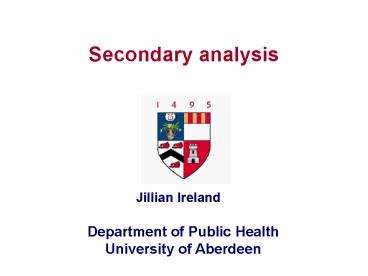Secondary analysis - PowerPoint PPT Presentation
1 / 25
Title:
Secondary analysis
Description:
... store data in electronic form in computer archives so that others can also ... purposes (e.g. viewing data for TV), crime statistics for policy-making, etc. ... – PowerPoint PPT presentation
Number of Views:26
Avg rating:3.0/5.0
Title: Secondary analysis
1
Secondary analysis
- Jillian Ireland
2
Secondary analysis definition
- Secondary analysis involves the utilisation of
existing data, collected for the purposes of a
prior study, in order to pursue a research
interest which is distinct from that of the
original work - (Heaton 1998)
3
What is secondary analysis?
- Secondary analysis uses existing data, e.g.
collected for a prior study or for policy-making
reasons, in order to address a new research
question or an alternative perspective on the
original question.
4
Plenty of data around
- Great mass of data is routinely collected by
governments, businesses, schools, and other
organisations. Much of this info is stored in
electronic databases that can be accessed and
analyzed. - Many research projects store data in electronic
form in computer archives so that others can also
analyze the data.
5
Re-using data sets
- Secondary analysis is efficient. It makes use of
data already collected (Research equivalent of
recycling). - Allows you to extend the scope of your study
considerably. E.g. in many research projects it
is impossible to consider taking a national
sample because of costs.
6
Advantages I
- Limited opportunities for conducting primary
research and costs of quantitative and
qualitative work have prompted researchers to
consider maximising use of existing data
available to them.
7
Advantages II
- In other words, you can conduct a much bigger
study (i.e. larger sample), then if you had to
conduct a primary study. A larger sample allows
you to do a more detailed (useful) statistical
analysis.
8
Advantages III
- Many archived databases are already national in
scope. Using these (perhaps linking different
databases), you can conduct a much broader study
than if you collected the data yourself with a
relatively small budget.
9
Advantages IV
- No need to get people to participate in new
research. - Unobtrusive measurement presumably reduces biases
that result from the intrusion of the researcher
(e.g. interviewer bias) or measurement
instrument.
10
Possible issues I
- Sample comparability
- In any attempt to aggregate or compare the data
from different official data files, significant
differences might be found in recording or coding
specific data.
11
Comparing countries
- Even within the UK in both health and education
there are many differences in coverage, time
periods, classifications, coding practices,
definitions, and other issues, between the
official statistics produced by Scotland, England
Wales, and Northern Ireland.
12
Possible issues II
- Original data for secondary analysis are
collected for a different reason, e.g. patient
data for service provision, marketing purposes
(e.g. viewing data for TV), crime statistics for
policy-making, etc.
13
Possible Issues III
- Using someone elses data greatly reduces the
degree of control the researcher has over the
type of data collected.
14
Possible Issues IV
- Using data sets collected by other researchers or
organisations you often don't know what problems
occurred during the data collection.
15
Example Quantitative
- Analysis of demographic details of season tickets
holders of a club, e.g. - Are women become season ticket holders at a later
age than men? - How likely is it that more than one season ticket
holder lives at same address?
16
Example MSc project
- Original study Postnatal Care in Grampian
n1249 - Secondary analysis Does attendance at antenatal
classes have an effect on the postnatal outcomes
of first-time mothers?
17
Advantages
- As slides 6, 7, 8, 9
- Plus, my supervisor was the author of the
original study (N.B. this could also be a
disadvantage choose carefully!) - Recoding was easy e.g. type of delivery was
changed from 5 codes to 2 normal or other
18
More advantages
- More time to spend on analysis (students often
leave too little time) - 3 methods descriptive statistics, multiple
logistic regression and matched pairs.
19
Issues
- Could not add questions (although, because the
original study was very thorough, this was
academic) - I would recommend secondary analysis!
20
Data Protection
- But 1998 Data Protection Act makes it difficult
to get access to the data. - For example, the University of Aberdeen cant
just give me as a researcher personal details
about you as a student for research purposes.
This includes your address!
21
Secondary analysis Qual. data
- Can involve the use of single or multiple
qualitative data sets - Can mix qualitative quantitative data sets
- Researchers could re-use own data or qualitative
data collected by others.
22
Example Qualitative
- Szabo Strang (1997) used secondary analysis
of their previous study on informal carers of
relatives with dementia to consider how carers'
perceived 'control' enabled them to manage their
care giving experience. - Szabo V. Strang VR. (1997) 'Secondary
analysis of qualitative data', Advanc Nurs Sci,
20 66-74.
23
Qualitative limitations I
- Some question whether secondary analysis of
qualitative studies as it involves an
inter-subjective relationship between researcher
and interviewee / focus group participants.
24
Qualitative limitations II
- Where does primary analysis stop and secondary
analysis start? Qualitative research is an
iterative on-going process and often the
questions undergo reformulation and refinement
over time.
25
Some useful references
- Corti, L Thompson P (2004) Secondary analysis
of archived data, In Qualitative Research
Practice by Seale, C et al. (Eds), Sage London. - Heaton J (1998) Secondary analysis of qualitative
data, Social Research Update 22 (web address
http//www.soc.surrey.ac.uk/sru/SRU22.html) - Hinds PS, et al. (1997) The possibilities and
pitfalls of doing a secondary analysis of a
qualitative data set, Qualitative Health
Research, 7 408-24 - Corbetta, P. (2003) Social Research Theory,
Methods Techniques, Sage, pp.150-152































